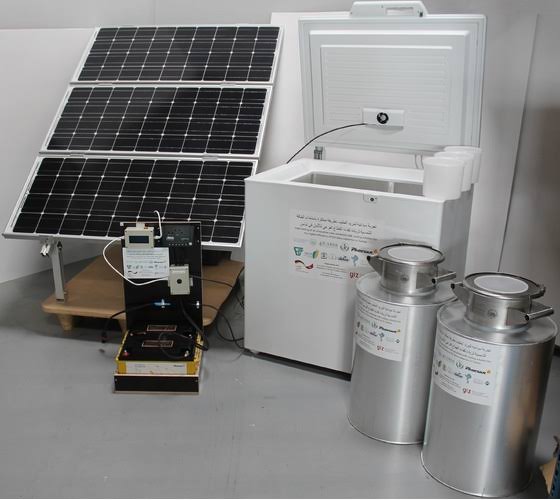Introduction
Milk is one of the most perishable agricultural products, highly prone to spoilage if not stored under the right conditions. In Nigeria and many other developing countries, smallholder dairy farmers often face huge losses due to the lack of cold chain infrastructure. Without timely chilling, raw milk spoils within a few hours, leading to reduced income for farmers and food insecurity in communities.
Solar-powered chilling units are emerging as an innovative and sustainable solution to this challenge. By leveraging renewable energy, they enable farmers and cooperatives in off-grid rural areas to preserve milk freshness, reduce post-harvest losses, and improve income generation.
- The Challenge of Milk Preservation in Rural Communities
High perishability: Raw milk spoils within 4–6 hours at ambient temperatures common in Nigeria (25–35°C).
Electricity gaps: Many dairy-producing regions lack stable grid electricity for refrigeration.
Economic losses: Spoiled milk leads to direct income loss for farmers and reduced availability of dairy products for consumers.
Food safety concerns: Spoiled milk can harbor harmful pathogens, posing public health risks.
- What Are Solar-Powered Chilling Units?
Solar-powered chilling units are off-grid refrigeration systems that use solar panels to generate electricity, which is then used to power milk chillers.
Key features include:
Solar Panels: Capture sunlight and convert it into electricity.
Battery or Thermal Storage: Stores excess energy for night-time or cloudy-day use.
Chilling Tank: Rapidly cools raw milk to around 4°C, preventing bacterial growth.
Scalable Capacity: Units can range from 50 liters (for small cooperatives) to 1,000+ liters (for larger collection centers).
- How Solar Chilling Units Work
- Milk Collection: Farmers deliver freshly milked raw milk to the chilling unit.
- Filtration & Initial Testing: Basic quality checks and filtering are done.
- Rapid Cooling: Milk is chilled from ambient temperature (~30°C) to below 4°C within 3–4 hours.
- Safe Storage: Chilled milk is stored in stainless steel tanks, maintaining freshness for up to 2–3 days.
- Transportation: Chilled milk can be transported to processing centers without spoilage.
- Benefits of Solar-Powered Milk Chilling
a. Reducing Post-Harvest Losses
Extends milk shelf life from a few hours to 2–3 days.
Allows farmers to bulk milk for collection without waste.
b. Improving Farmer Incomes
Farmers earn more by selling higher volumes of unspoiled milk.
Cooperative groups can negotiate better prices with processors.
c. Enhancing Food Safety
Properly chilled milk reduces bacterial contamination.
Consumers gain access to safer, healthier dairy products.
d. Promoting Sustainability
Solar energy reduces reliance on diesel generators.
Cuts carbon emissions and supports climate-smart agriculture.
e. Empowering Women and Youth
Women, who make up a large percentage of Nigeria’s smallholder dairy workers, benefit from reduced losses and better market opportunities.
Youth can manage solar chilling operations as local entrepreneurs.
- Case Studies in Africa
Kenya: Solar milk chillers deployed in rural communities helped smallholder dairy farmers reduce spoilage by up to 80%.
India: Portable solar chillers supported village cooperatives, increasing farmer earnings by 30%.
Nigeria: Pilot projects in northern states (Kaduna, Plateau, and Kano) are introducing solar milk chilling hubs, supporting Fulani pastoralists in preserving milk for larger buyers.
- Challenges to Adoption in Nigeria
High Initial Costs: Units can cost between ₦2 million–₦8 million, limiting affordability for individual farmers.
Maintenance and Technical Skills: Rural communities may lack trained technicians for repairs.
Financing Models: Limited access to credit and cooperative financing slows adoption.
Awareness Gap: Many farmers are not yet familiar with solar cooling technologies.
- Pathways to Scaling Solar Chilling in Nigeria
- Government and Donor Support: Subsidies, grants, and credit schemes for dairy cooperatives.
- Public–Private Partnerships: Collaborations between solar tech companies and dairy processors.
- Pay-As-You-Go Models: Farmers contribute a small daily fee for access to chilling services.
- Capacity Building: Training local technicians and farmers in unit operation and maintenance.
- Integration with Dairy Value Chains: Linking solar chilling hubs with milk processing companies for guaranteed offtake.
Conclusion
Solar-powered chilling units represent a game-changing innovation for the Nigerian dairy sector. By addressing the twin challenges of milk spoilage and energy access, they create opportunities for food security, farmer income growth, women’s empowerment, and sustainable agriculture.
With the right investments, financing models, and capacity-building efforts, Nigeria can establish a robust cold chain for dairy, ensuring that fresh milk from rural communities reaches households and processing plants without waste. Solar chilling is not just a technology—it is a pathway toward transforming Nigeria’s dairy industry for the future.

